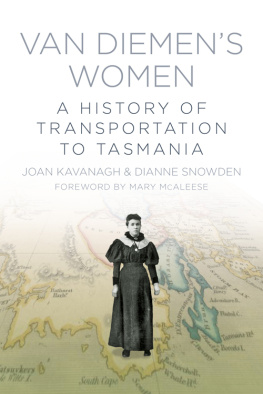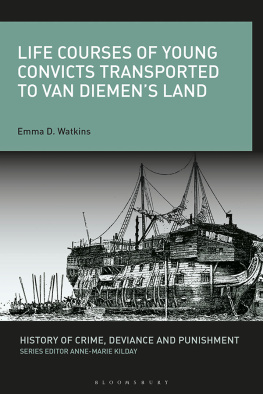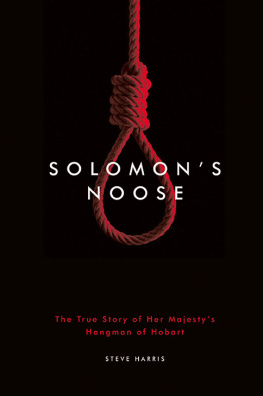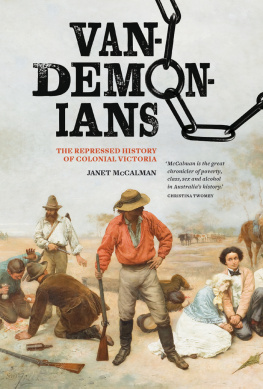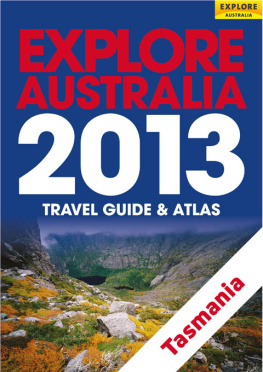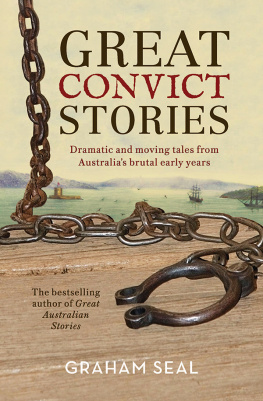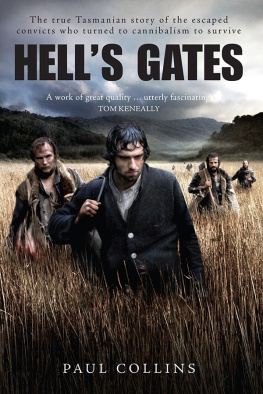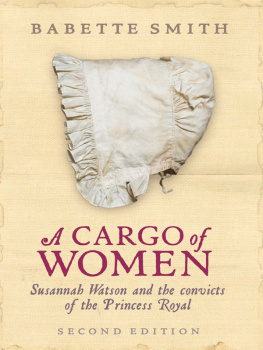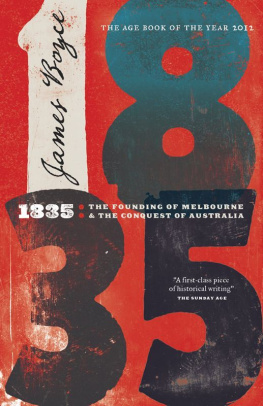

Dedicated to the women and children
of the Tasmania (2) and especially
Eliza Davis and Margaret Butler
The names of the convict women have been recorded according to the spelling on the convict conduct record [CON41/1/8], with three exceptions: Esther Burgess is referred to on her conduct record as Burges; she appears as Burgess in the text. Mary Byrnes conduct record refers to her as Bryne and on her indent she is Mary Byrne; she is referred to as Mary Byrne. Eliza Davis is referred to as Elizabeth Davis in the convict records but she was generally known as Eliza and is referred to as such in this book. All other spelling of names are according to the document being used. The difficulty caused by name variations is highlighted by Mary Byrnes son, James Burns, also known as James McCann. Mary married as Bryan. Similarly, Mary Griffens children were consistently recorded as Griffin from the time they were in Grangegorman Female Convict Depot in Dublin. Alternative spellings are shown like this: Meagher (for Mary Meaghar).
Because the one described in this book was the second voyage of the Tasmania as a convict ship, it was styled the Tasmania (2) and it is referred to in this way in the text.
Where two convicts of the same name arrived on a convict ship, they were differentiated by the addition of 1st, 2nd, or 3rd on their convict records. There were two women named Margaret Butler on the Tasmania (2). The colonial authorities labelled them Margaret Butler 1st and Margaret Butler 2nd to distinguish them.
Biographies of the 138 women and 35 children, with detailed references, will be available in 2016 on http://dsnowden.edublogs.org .
It is not always possible to determine if a particular record relates to a particular convict, especially for birth, death and marriage records. Where we consider a record is likely to be relevant, even though it is unsubstantiated, we have added it to the end of the individual biography.
The idea for this book germinated at the 1998 Irish-Australian Conference at La Trobe University in Melbourne. Seventeen years later, we are proud to present this book, the story of the women and children of the Tasmania (2).
Many people have been on this journey with us and we acknowledge their contribution with thanks.
For graciously agreeing to write the foreword for our book, we thank Mary McAleese, President of Ireland 19972011.
Dr Conor Fitzgerald GP and Dr John McManus GP for reading Surgeon Superintendent Lardners journal and providing information about the shipboard complaints of the women and their children.
For shipping information, John Woods, Local Studies Library, Sunderland City Council and Captain John Barlow, Wicklow town harbour master.
In Ireland, the Director of the National Archives of Ireland, and the staff: Aideen Ireland, Gregory OConnor, Brian Donnelly, Jennifer Dunne and the lads. In the National Library of Ireland, Mary Broderick, David Phelan and Glenn Dunne. In the National Museum of Ireland, Lorna Elms, Finbarr Connolly and Noel Campbell. At Wicklow County Council, friends and former colleagues: Blaise Treacy, Tom Broderick, Eddie Sheehy, Lorraine Gallagher, Christine Flood, Sen ONeill, Catherine Wright, Deirdre Burns, Aisling Lynch, Marion Fitzpatrick, the late Darragh Murphy, Pat Casey, the BTC gang and Colin Fulham. Wicklows Historic Gaol manager, Emeir OConnell and the gaolers Marie Comerford, Christine Murley, Patrick Mahood, James Murphy, Miriam Keegan and Tara Canavan. Lorraine McCann, archivist, Louth County Archives Service. The late Richard Bennett for bringing us around Grangegorman. Richard McCormick of the National Maritime Museum, Dn Laoghaire; John Finlay and Joe Roberts for the photo of Wicklow Gaol; Martin Critchley for his maps. Stuart Rosenblatt of the Irish Jewish Museum and Catherine Cox of University College Dublin; Linda McKenna and Lesley Simpson, Down County Museum; Danny Cusack, an Aussie in Ireland; Fintan Vallely who searched the music archives for the The Irish Girl and Emily Cox for her support; John Kearney and Amanda Pedlow, Offaly Historical and Archaeological Society; Sr Marie Bernadette, Sisters of Charity Archives.
A special thank you to Douglas and Linda Wilson in Wicklow for their generosity in opening up their home, Cronelea House, Shillelagh, where Elizas life in Wicklow began.
Staff in the library and archives services throughout Ireland have been most helpful and courteous in responding to requests for assistance: Carmel Flahavan, Janette OBrien, Clodagh Kinsella and Deirdre Condron, Carlow; Jonathan Smyth, Cavan; Peter Beirne, Clare; Kieran Wyse, Cork; Helen McNutt and Una Mathewson, Donegal; Nigel Curtin, Dn Laoghaire; Mike Lynch, Kerry; Mario Corrigan, Kildare; Jean Coughlan, Kilkenny; Bernie Foran and Bridget McCormack, Laois; Mary Conefrey and Thecla Carleton, Leitrim; Tony Storan, Limerick; Martin Morris, Longford; Alan Hand, Louth; Ivor Hamrock, Mayo; Tom French, Meath; Caitriona Lennon, Monaghan; Caitlin Browne and Richie Farrell, Roscommon; Mary Guinan-Darmody, Tipperary; Anne Lenihan, Waterford; Gretta Connell, Westmeath; Nicola McGrath, Wexford; and last but by no means least, Brendan Martin, Michael Kelleher, Robert Butler and all the staff in Wicklow County Library Service.
In England, the War Graves Photographic Project for images of the burial places of the descendants of the Tasmania (2) women and their prompt and efficient service.
In Australia, the staff of the Tasmanian Archive and Heritage Office; the Tasmanian Museum and Art Gallery (for the image of the solitary box); the National Archives of Australia; State Records of NSW (for the image of the Anson ); State Library of Victoria (for the image of St Josephs Orphanage); and the Powerhouse Museum (for the image of the Tasmania ) . To Brian Rieusset, Trudy Cowley and Mark Krause for sharing their images, and special thanks to Brian Andrews for the images of the reinterment of Judith Dooling, or Dowling, and for his interest in our project.
We also thank the Tasmanian Family History Society (formerly the Genealogical Society of Tasmania); the Friends of the Orphan Schools, especially Joyce Purtscher and Rosemary Davidson; the Female Convicts Research Centre; and Greta McDonald, site manager, Cascades Female Factory; Thelma McKay; the late Denise McNiece; Ray Thorburn; Coral Stubbs and Eddie OToole for kick-starting the research on Eliza Davis in Tasmania.
For information about Eliza Davis and photos of Eliza and her family, we thank descendants Bryan Lucas, Bronwyn Meikle, Gail Mulhern, Beverley Gellatly, the late George Hughes and Linda Hughes, and especially Bryan Lucas and Beverley Gellatly for generously sharing their photo collections and for providing additional information. Over many years, several of Elizas descendants have provided information about this remarkable woman and we thank them for their interest and support. We also thank Georgia Wade at the Burnie Regional Museum for her interest in Elizas story. For information about Margaret Butler and photos of her family, we thank descendants Les Butler; Betty, Cheryl and Sharon Whitney; Janet Hammon (for the photo of Margaret Lundie); and especially Beryl Snowden who, although not a descendant, has provided invaluable support and information over many years.
For information about the other women and their children, we are indebted to many fellow historians and researchers: for Esther and Mary Burgess, we thank Caroline and Emily Williams, Yvonne Jones, Peter Page; and for Ann Burgess, Barbara Simpson and Perry McIntyre. We especially thank Kevin Reed for kindly allowing us to use photos from his collection and for providing additional information; for Bridget Gallagher, we thank Harriet Taylor and Shirley Joyce in New Zealand; and for Mary McBride, Cheryl Griffin and Anne Kiely.
Next page
